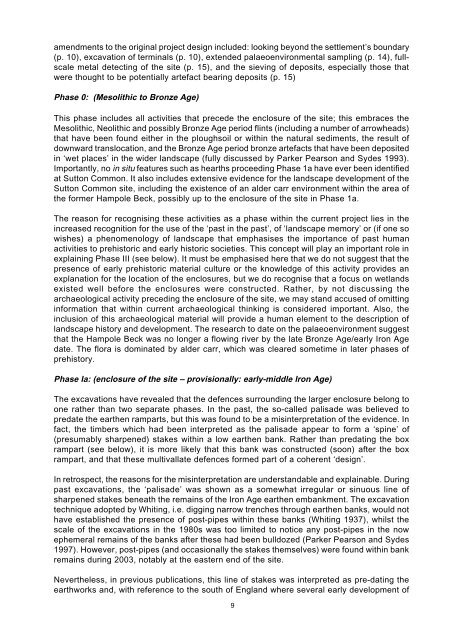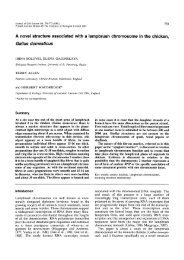Sutton Common Updated project design - University of Exeter
Sutton Common Updated project design - University of Exeter
Sutton Common Updated project design - University of Exeter
Create successful ePaper yourself
Turn your PDF publications into a flip-book with our unique Google optimized e-Paper software.
amendments to the original <strong>project</strong> <strong>design</strong> included: looking beyond the settlement’s boundary<br />
(p. 10), excavation <strong>of</strong> terminals (p. 10), extended palaeoenvironmental sampling (p. 14), fullscale<br />
metal detecting <strong>of</strong> the site (p. 15), and the sieving <strong>of</strong> deposits, especially those that<br />
were thought to be potentially artefact bearing deposits (p. 15)<br />
Phase 0: (Mesolithic to Bronze Age)<br />
This phase includes all activities that precede the enclosure <strong>of</strong> the site; this embraces the<br />
Mesolithic, Neolithic and possibly Bronze Age period flints (including a number <strong>of</strong> arrowheads)<br />
that have been found either in the ploughsoil or within the natural sediments, the result <strong>of</strong><br />
downward translocation, and the Bronze Age period bronze artefacts that have been deposited<br />
in ‘wet places’ in the wider landscape (fully discussed by Parker Pearson and Sydes 1993).<br />
Importantly, no in situ features such as hearths proceeding Phase 1a have ever been identified<br />
at <strong>Sutton</strong> <strong>Common</strong>. It also includes extensive evidence for the landscape development <strong>of</strong> the<br />
<strong>Sutton</strong> <strong>Common</strong> site, including the existence <strong>of</strong> an alder carr environment within the area <strong>of</strong><br />
the former Hampole Beck, possibly up to the enclosure <strong>of</strong> the site in Phase 1a.<br />
The reason for recognising these activities as a phase within the current <strong>project</strong> lies in the<br />
increased recognition for the use <strong>of</strong> the ‘past in the past’, <strong>of</strong> ‘landscape memory’ or (if one so<br />
wishes) a phenomenology <strong>of</strong> landscape that emphasises the importance <strong>of</strong> past human<br />
activities to prehistoric and early historic societies. This concept will play an important role in<br />
explaining Phase III (see below). It must be emphasised here that we do not suggest that the<br />
presence <strong>of</strong> early prehistoric material culture or the knowledge <strong>of</strong> this activity provides an<br />
explanation for the location <strong>of</strong> the enclosures, but we do recognise that a focus on wetlands<br />
existed well before the enclosures were constructed. Rather, by not discussing the<br />
archaeological activity preceding the enclosure <strong>of</strong> the site, we may stand accused <strong>of</strong> omitting<br />
information that within current archaeological thinking is considered important. Also, the<br />
inclusion <strong>of</strong> this archaeological material will provide a human element to the description <strong>of</strong><br />
landscape history and development. The research to date on the palaeoenvironment suggest<br />
that the Hampole Beck was no longer a flowing river by the late Bronze Age/early Iron Age<br />
date. The flora is dominated by alder carr, which was cleared sometime in later phases <strong>of</strong><br />
prehistory.<br />
Phase Ia: (enclosure <strong>of</strong> the site – provisionally: early-middle Iron Age)<br />
The excavations have revealed that the defences surrounding the larger enclosure belong to<br />
one rather than two separate phases. In the past, the so-called palisade was believed to<br />
predate the earthen ramparts, but this was found to be a misinterpretation <strong>of</strong> the evidence. In<br />
fact, the timbers which had been interpreted as the palisade appear to form a ‘spine’ <strong>of</strong><br />
(presumably sharpened) stakes within a low earthen bank. Rather than predating the box<br />
rampart (see below), it is more likely that this bank was constructed (soon) after the box<br />
rampart, and that these multivallate defences formed part <strong>of</strong> a coherent ‘<strong>design</strong>’.<br />
In retrospect, the reasons for the misinterpretation are understandable and explainable. During<br />
past excavations, the ‘palisade’ was shown as a somewhat irregular or sinuous line <strong>of</strong><br />
sharpened stakes beneath the remains <strong>of</strong> the Iron Age earthen embankment. The excavation<br />
technique adopted by Whiting, i.e. digging narrow trenches through earthen banks, would not<br />
have established the presence <strong>of</strong> post-pipes within these banks (Whiting 1937), whilst the<br />
scale <strong>of</strong> the excavations in the 1980s was too limited to notice any post-pipes in the now<br />
ephemeral remains <strong>of</strong> the banks after these had been bulldozed (Parker Pearson and Sydes<br />
1997). However, post-pipes (and occasionally the stakes themselves) were found within bank<br />
remains during 2003, notably at the eastern end <strong>of</strong> the site.<br />
Nevertheless, in previous publications, this line <strong>of</strong> stakes was interpreted as pre-dating the<br />
earthworks and, with reference to the south <strong>of</strong> England where several early development <strong>of</strong><br />
9
















